As an Amazon Associate I earn from qualifying purchases.
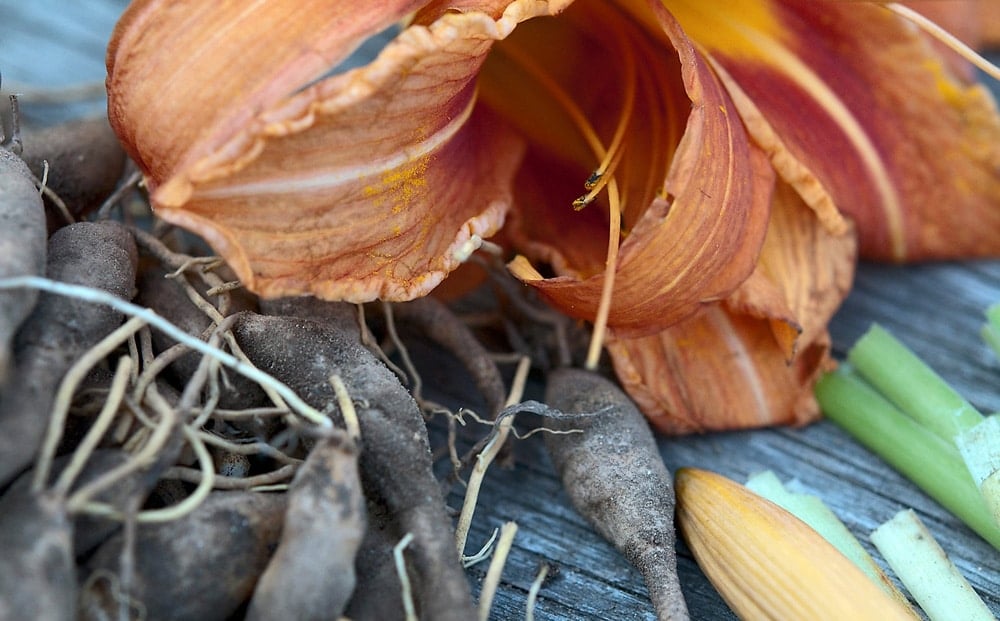
Daylilies are not only edible, they are spectacular. After sampling the flowers, flower buds, young stalks and root tubers, I’ve come to the conclusion that they’re so tasty I may grow them as a food crop.
Let me start by saying that edible daylilies are the common daylily, Hemerocallis fulva, as well as its various Hemerocallis friends and relatives; there are thousands. What I am most definitely not talking about are bona fide lilies, like the Easter lily, which, if you are unfortunate enough to eat, you had better hope that the Resurrection is real…
I’d read long ago about the edibility of the common lily of my youth, which we incorrectly called tiger lilies because of their orange stripes. But this would have been in the 1980s, when edible flowers reached their trendy zenith. Nasturtium flowers all over the plate, anyone? Meh. My young self wrote off lilies as part of that prancy fad.
I first foraged for daylilies in Massachusetts, years ago. Any of you ever been to Cape Ann? Gloucester is covered in daylilies, and its ritzier neighbor Rockport has more daylilies than grass. Daylilies are the most common flower on the whole freaking island. So common my sister Lizz and my brother-in-law Mark have tons of them in their tiny yard.
So I am sorry to tell you there will be no stirring tale of high adventure as we stalked the semi-wild daylily. Nope. We just pulled a few plants and picked the flowers and buds from some others that were in the yard.
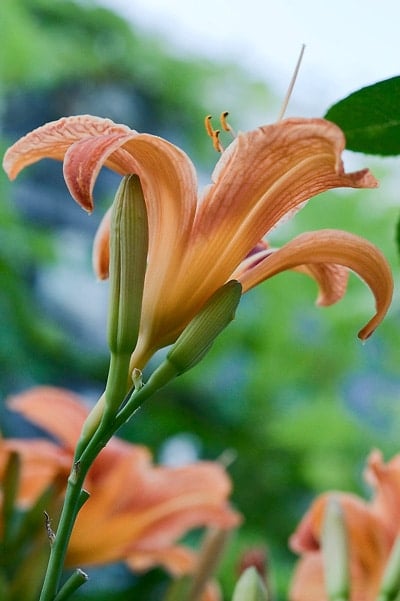
The drama with daylilies is all in the eating.
I first separated the plants into flowers, buds, and tubers — unlike true lilies, daylilies don’t have bulbs, they have little tubers instead that look like miniature fingerling potatoes. I then stripped the outer leaves from those plants that had not yet flowered, until I got to the white part.
Most sources say to saute the unopened flower buds with a little butter or oil and call it a day. Sounded like a plan, especially since I wanted to really taste the plant, not any supplemental seasonings. So in they went, just lily buds, butter and salt.
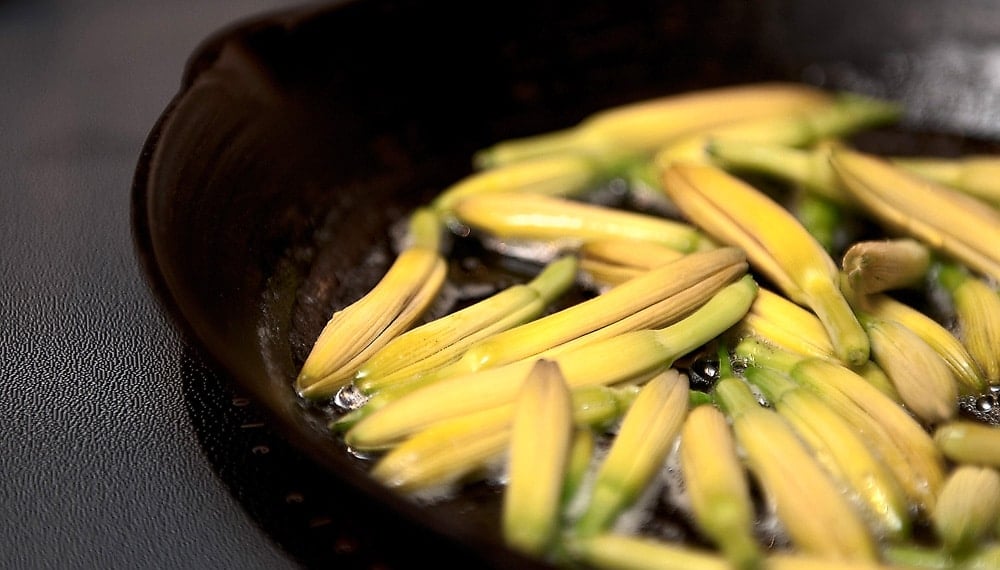
Delicious. Briefly cooked, the buds have a bit of knacken, a German expression meaning a “pop.” Yet the insides reminded me of squash blossoms. The taste? Green, with a whiff of radish and a dash of green bean. Honestly, I’d eat this as a side dish any day, any place. It needs nothing else.
We tried some of the stalks, but they were not as good. Texture like lemon grass, only without the wonderful lemon aroma. More like a bland, tough scallion. Certainly edible, and not terrible, but nothing like the buds.
The flowers are OK. They are more for color than flavor, and they are said to thicken soups the way okra or file powder do. The Chinese use them in hot-and-sour soup. Will have to try that more some other time.
That left the little tubers. First thing I noticed was that some looked exactly like fingerling potatoes, while others were pure white, like the inside of jicama. I ate a white one, and it tasted like jicama — only better. Like a raw sweet potato. Or rather a sweet, raw potato, not a yam.
I did the same treatment to the tubers: Butter, salt, saute. Only I added some black pepper this time. I like black pepper on my potatoes, so I reckoned I’d like this, too.
I was right. These are quite possibly the best tubers I’ve ever eaten. OK, that might not sound like ringing praise, but consider that I am including real potatoes in there and you get the picture.
Think really young fingerling potatoes, only with a sweetness to them. White ones are sweeter than the yellow ones. Yellow ones seem more substantial.
The only things daylilies have against them are allergies and size. A small number of people who eat daylily flowers get farty and nauseous afterwards; I hear “less than 5 percent” a lot, but I can’t verify it. Suffice to say you should eat only a little at first, the have at it.
The second “strike” against the lily, if it can be called one, is size: You’d need to uproot about five or six plants for one meal. But when you consider that hemerocallis fulva is considered a noxious weed in many of the 42 states it’s gone feral in, go ahead. Dig away.
Doing a little more research, I find that according to the USDA, the daylily has gone wild in every state except Alaska, Hawaii, Oklahoma, North Dakota, New Mexico, Arizona, Nevada, and, um, my own state of California. Sigh.
That said, you can’t swing a dead cat without seeing a planting of edible daylilies in a parking lot or person’s house, and they are so common in urban settings Charlotte Bringle Clarke writes about them in her Edible and Useful Plants of California.
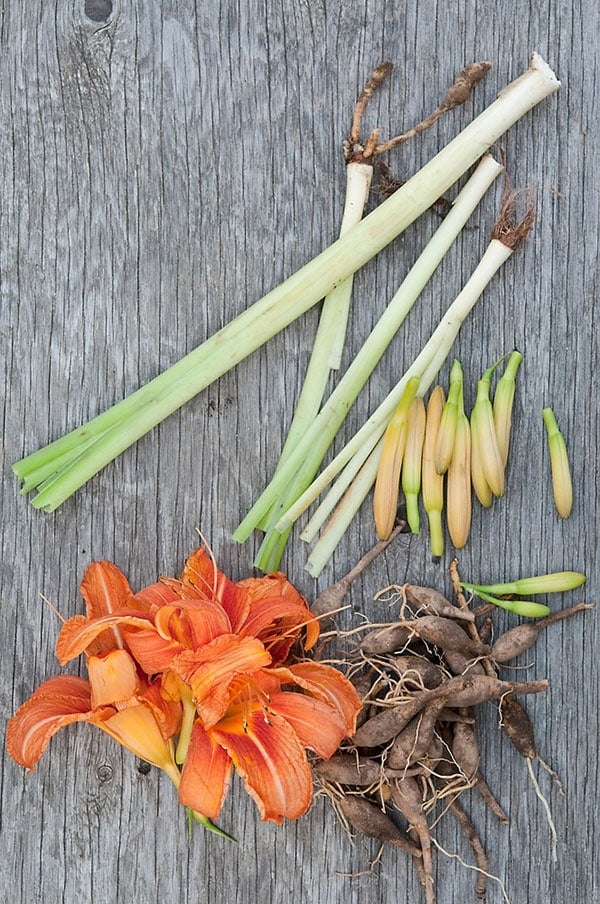
Daylilies originally came from Asia, probably China. Chinese cooking uses them all the time, even in such starring dishes as moo shu pork and hot-and-sour soup. You will often see dried flowers called “golden needles.”
Euell Gibbons liked to batter-fry the buds, and lots of other old-timers “creamed” their daylily tubers, which sounds unappetizing. But beyond hippie forager types and the Chinese, I’ve found no other use of the daylily as food.
Pity. It is, as Jimmie Walker would say, Dy-No-Mite.


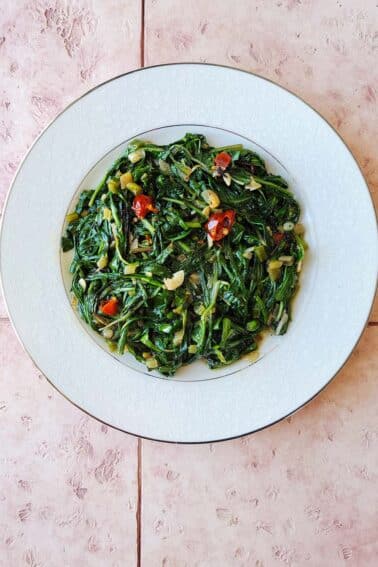
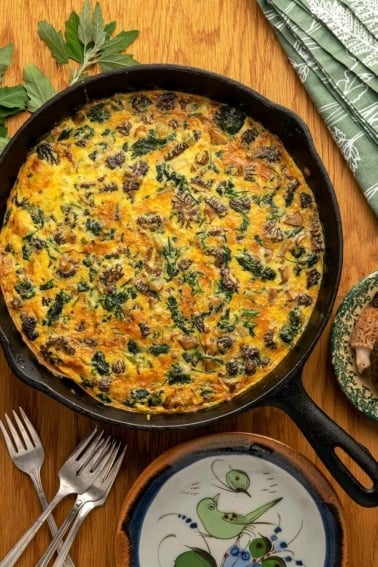
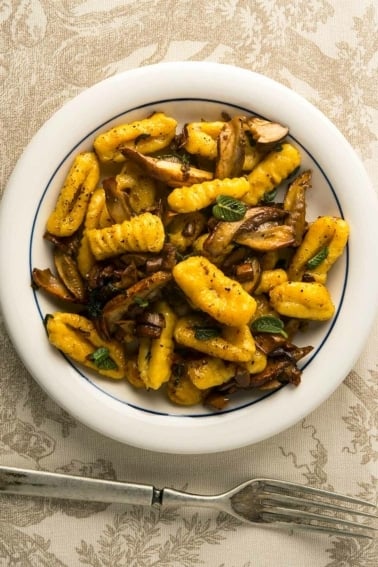
I find daylily petals are lovely in salads. Or as edible decorations. They have a light, pleasant flavour.
I have heard you can make a syrup from daylilies. i was wondering if maybe being cooked instead of raw may make a difference. You steep the flowers using boiling water let sit over night. Then strain them. If you have 5 cups of liquid you add almost 5 cups sugar. They used raw cane sugar which I guess is less sweet. Then you boil it down down like you would maple sap. Taking off the foam as it boils. Check the consistency of your syrup you want it to be cold it is thicker then. So take a sample out get it chilled to see if it is how you like it. Some like real thick syrup some like it more runny. I plan on trying it myself in a small batch to see how it taste.
I have eaten raw day lily flowers in a salad a few times before yesterday and experienced no issues. Yesterday I added six or eight flowers and as many buds to my lettuce, beets, and feta salad. It was one of the best salads ever! About an hour after dinner, I began to feel queasy and experience intestinal cramps. For about the next six hours my entire gastrointestinal system violently erupted in a way that rivaled those colonoscopy prep solutions. It ended when there was nothing left. The lilies are the prime suspects because I have eaten all other ingredients from that dinner today and experienced no issues.
I wonder if they have some sort of anti microbial or anti viral constituents? I know that when I’ve taken licorice root for a sickness or flu in the past, the outcome has been the same. Not pleasant at all- but definitely eliminated the virus! Haha
My daughter and i like to munch on them raw and toss a few in salads. She also pickled some of them and they were delicious ?
Very interesting. I already have a problem with Chrons. I eat as many veggies as I can that don’t blow me up. For my safety sake, which daylilly(s) would not tear me up? I love cauliflower but it’s hard on my body, like broccoli and beans. Would you send me pictures of them or It?
Thank you ahead of time.
Laura: I can’t really answer that, and if you have Crohn’s Disease, I’d advise against eating them.
First off, I laughed out loud when you referenced eating an Easter Lily and the Resurrection. Seriously, so funny.
So my question is: do you think one could use the blossom of a day lily similar to squash blossoms? Last summer I was obsessed with batter fried stuffed squash blossoms (so good) and I have enough day lilies to start my own nursery I swear! So, has anyone tried using the open flower much like squash blossoms–filled with cheese and deep fried?
Daylilys tend to split and into sections so it would probably be impossible to stuff them
Hi Hank, Getting ready to make hot & sour soup and noticed the addition of day lilies. Back in the day (Euell Gibbon’s time) we gathered some buds and boiled them, as I recall. They tasted like green beans, but the best thing was the purple color of the water they were cooked in. I used to do a lot of natural dyeing so this was a bonus! Thanks for your article.
I was really excited to find your blog and this article in particular, as I have a profusion of day lilies on my 1/4-acre, planting by previous owners. Because of this post, my husband and I tried harvesting and eating them yesterday.
First, let me say that we have harvested and either eaten many plants from our garden or turned them into medicinal tinctures. This includes a mushroom successfully ID’d as reddening lepiota, wild geranium, and cleavers, among others. We blog about our permaculture/native plant experiment over at http://www.catintheflock.com.
We verified that the lilies growing in our plot were indeed the common ‘ditch lily’ and harvested them fresh. Our garden is 100% organic. We tried a small handful each of the tubers, with a few flower buds and blooms, which we sautéd in butter with salt and pepper, just as you describe. But the results were disastrous. I was knocked out with a strange sleep for an hour and a half in the middle of a sunny day, in which I neither moved nor awakened. This is strange for me, as I’m not a napper. When I woke, I experienced a full six hours straight of violent diarrhea, with extreme flatulence. My husband also had diarrhea, though his was milder.
Given our bodily rejections to the ditch lily as food, I have to ask, Where did you get the statistic that only 5% of people react negatively to them? Since my husband also had a negative digestive response, and mine was so extreme, I would absolutely not recommend ditch lilies as a food to anyone, and I sincerely caution you against doing so, especially with such glowing enthusiasm. They tasted… OK. I’d rather have a regular ol’ potato, and I’d have saved myself an evening of absolute misery if I’d passed on these.
I’ve taken a number of classes from a man named John Kallas. He said that one wild food expert had day lillies that caused a whole group of people to get nauseous and experience vomiting and diarrhea. If my memory serves me correctly (it was about five years ago) he believes there is likely a variant that does make people sick. That and some people are just sensitive to it. Some people are also allergic to strawberries. Happens.
Had a similar experience with violent diarrhea myself from eating raw flowers and buds in a salad yesterday. Funny thing is I have eaten them, from the same source in my yard, before, with no issues. But this time all hell broke loose! Felt great when it all ended, and my system was emptied.
Hi Hank, I didn’t see any mention about the potential for these to cause diarrhea and nausea, which is reported elsewhere on the internet. It has now happened to me twice, the first time from cooked ripe flower buds and the second time from the same combined with several raw open flowers that I ate along with my meal. My wife got diarrhea that second time too eating the same thing. I love daylilies like you do, but maybe we overdid it? It wasn’t like we ate a whole plateful or anything. I am really not too concerned, but will have to take it easy next time. It could have been a detox reaction I suppose and a good thing. I’ve seen people get the runs from a wild green pesto. In any event, thanks for all you shared.
Ryan: It’s mentioned in the article. My advice is to lay off them. If you’ve had GI issues twice now, you are one of the people who are susceptible to it. Bummer, but it happens with some food or another to most of us.
My property used to be a daylily farm, so they’re in random places all over the yard and they definitely seem to be multiplying over time. I’m going to try and dig them up this year and relocate them to a bed, so I won’t have to choose between mowing over them or around them. I knew they were edible, but I haven’t tried any yet. Maybe I’ll experiment this weekend.
I love the buds raw or cooked and have been enjoying them for years. I also put the dried petals on my salads, very tasty raw. I go to some wild spots to harvest but this spring I put some in my garden so I can harvest the tubers when they need thinning.
I’ve read that since colonial times some 60,000 varieties of daylillies have been developed and not all of them are edible as the original brought over by the colonists is. Perhaps that’s why some people got sick? I’ve only ever eaten the unopened flower buds and sometimes they are very good. Sometimes not so much.
Are stella de oro day lilies w\edible ?
Yes
I hate to be a downer, but apparently I am part of the percentage that gets sick. Shortly after eating some raw shoots and tubers, my stomach was turning and within half an hour they had violently made their exit. I am certain they were from the correct plant. Kind of bummed because they are so plentiful and I keep pulling them out when they start to encroach on my lawn. But anyway, do be cautious when trying this one.
Are you sensitive to raw spinach or avocados. I am and I’m just wondering because I would like to try these since I have so many but I do not like feeling unwell.
With zucchini blossoms, I like to stuff the unopened but with a little mild, melty cheese, the whisk them thru a light batter and fry them. Wondering if this might also work with daylilies?
From my research the daylily may contain too much oxalic acid for it to be consumed regularly.
Different species may be more edible than others. The Golden Needles is H. citrine which is considered a vegetable. The old cultivar Hyperion is hybrid out of citrine and the Orange Ditch Lily H. fulva is a ancient sterile hybrid a triploid derived from crossing a diploid and a tetraploid.
I’m told that the old folks from around here only ate the yellow daylilies which was probably the cultivar Hyperion.
Try the white part of the shoot raw in spring as they are just coming up. I think you will find it an entirely different experience.
I just ate two unopened flower buds. They tasted good, but I am going to wait a day to make sure I don’t have a problem with them.
Thanks for this! I just ate my first ditch lily tubers sauteed in butter salt and pepper. Very good! Cheers.